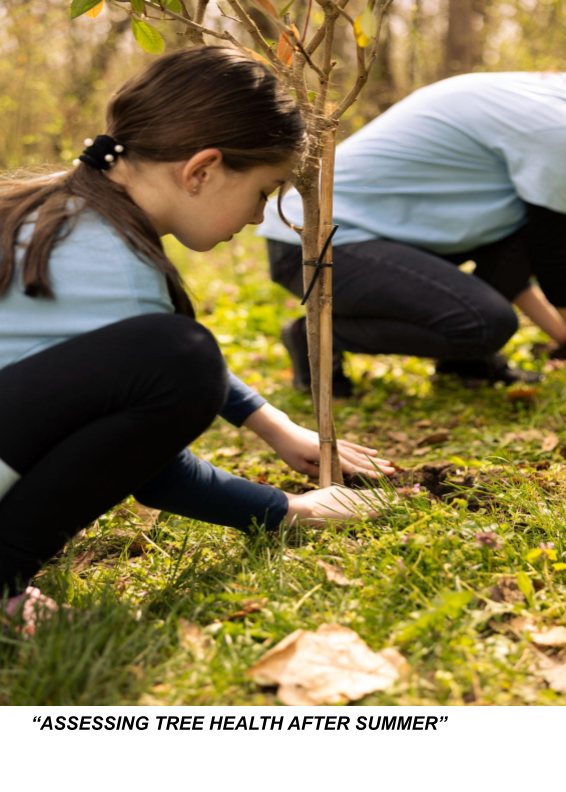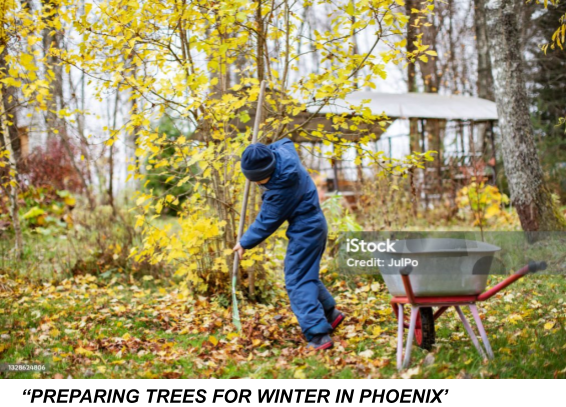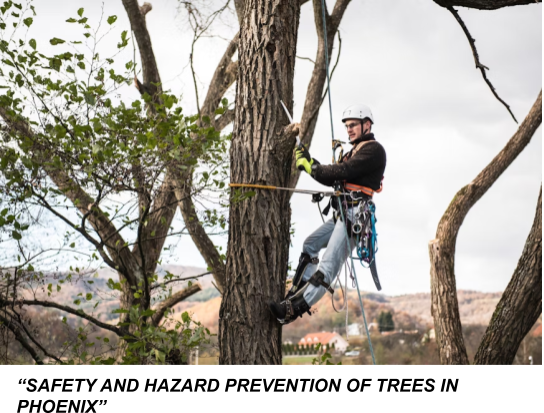
Fall is a good time for Phoenix homeowners to care for their trees so they stay healthy through hot summers and cooler winters. The desert heat can stress trees, causing weak branches, sunburn, and decay.
With winter coming, fall tree care keeps your yard safe and looking good. This guide shows how to care for Phoenix trees: check their health, prune branches, fertilize, take care of roots and soil, and get them ready for winter.
By following these simple tips, your trees can stay strong, healthy, and vibrant all year.

Understanding Phoenix’s Fall Climate and Its Effects on Trees
Phoenix experiences extremely hot summers followed by milder fall temperatures. As the weather begins to cool, the trees often still carry the stress of the intense summer heat. Understanding how the local climate affects your trees is the first step in maintaining healthy trees in your yard.

Summer Heat Stress
- Phoenix’s summer temperatures can reach over 110°F (43°C), leaving many trees dehydrated.
- Prolonged heat exposure can cause leaf scorch, weak branches, and brittle wood.
- Even hardy desert trees like mesquite and Palo Verde show signs of stress if watering and soil conditions are inadequate.
Early Fall Changes
- Fall brings cooler nights (50–70°F / 10–21°C), but daytime temperatures remain warm.
- The change in season can make trees grow slower and get ready for winter rest.
- Proper fall maintenance helps trees recover from summer stress and prepares them for the upcoming winter months.
Assessing Tree Health After Summer
- Before performing any maintenance, it is essential to evaluate your trees’ overall health. Fall is a great time to check your trees. As they move from hot summer to cooler weather, it is easier to see any damage or stress. Checking them carefully helps pruning, fertilizing, and pest control work better.

Look for Heat Damage.
- Inspect leaves for browning, curling, or sunburn marks. These signs often indicate that the tree has been under prolonged heat stress or insufficient watering. Examine branches for cracking, splitting, or brittle wood, which can compromise structural integrity. Check the trunk for signs of sun scald or damage from pests attracted to stressed trees. Also, watch for new growth—small or misshapen shoots can show your tree is stressed from the heat.
Detect Internal Decay and Disease
- Look for fungal growth at the base or on limbs, which may indicate internal rot. Early detection of fungi or cankers can prevent serious structural issues later. Cracks or holes in branches can make them break and be dangerous for your property and family. Remove any dead or dying branches right away. You can also use a tool or hire an arborist to check for hidden decay inside big branches or the trunk.
Identify Pest
- In Phoenix, spider mites, aphids, and borers often attack trees in summer, especially those stressed by heat. Look for tiny holes in leaves, sticky residue, or insects. Treat pests in the fall to stop them from spreading before winter. Check both the top and bottom branches, since pests often hide. Watching for pests now can reduce tree damage and make spring treatments easier.
Fall Pruning and Shaping.
Pruning in the fall is essential for maintaining tree health, safety, and aesthetics. Fall helps trees bounce back from summer heat and prepare for cooler weather. Pruning improves airflow and sunlight, keeps trees healthy, and helps your yard stay safe and attractive.

Why Fall Pruning Matters
- Helps remove deadwood or hazardous branches weakened by summer heat. Dead branches can become brittle and pose serious safety risks during winter storms or high winds.
- Shapes the tree to improve airflow and reduce disease risks. Well-shaped trees are less likely to develop fungal infections or pest infestations.
- Prepares trees structurally for winter storms or wind. Pruning in the fall helps balance the tree, preventing broken branches and weak structure.
- It also encourages healthy growth and can boost flowers and fruit next season.
Pruning Guidelines for Phoenix Trees:
- Focus on removing dead or broken branches first, as they pose the highest risk for damage.
- Don’t do heavy pruning in late fall. Light pruning is safer and prevents extra stress on trees in cooler weather.
- Use clean, sharp tools to make cuts that heal quickly and prevent disease.
- Remove branches that cross or rub against each other to avoid damage.
- Keep the natural shape of desert trees like mesquite or Palo Verde so they stay strong and look natural.
Common Mistakes to Avoid:
- Cutting too much foliage at once can stress the tree and reduce its ability to store energy for winter.
- Pruning during periods of extreme temperature swings, as sudden cold or heat can shock the tree and slow healing.
- Ignoring internal decay can lead to unexpected limb failure despite healthy-looking leaves.
- Using dull or dirty tools can tear bark and make trees more likely to get disease.
- Cutting the wrong branches or too much can upset the tree’s balance and make it weaker in the wind.
Fertilizing and Soil Care:
Fall is the ideal season to focus on soil health and provide essential nutrients for your trees.
After hot summers, fertilizing trees and caring for the soil helps them recover, grow strong roots, and get ready for winter. Healthy soil helps trees get nutrients, retain water, and stay free from disease.

Fertilization Tips for Phoenix Trees:
- Use slow-release nitrogen fertilizer to help roots grow and keep trees healthy in fall and winter.
Don’t use too much—desert trees need less, and extra fertilizer can hurt roots or make weak leaves. - Fertilize early in fall, so trees absorb nutrients before winter.
- Test the soil to see what nutrients are missing and choose fertilizer made for desert trees like mesquite, Palo Verde, and citrus.
- Add minerals like magnesium, iron, and zinc if needed to keep leaves healthy and trees strong.
Soil Maintenance
- Aerate soil around the tree to prevent compaction caused by summer activity, foot traffic, or garden equipment. A loose soil improves oxygen and water penetration to the roots.
- Add organic mulch around the base, keeping it 3-4 inches from the trunk to prevent rot and pest issues. Mulch also helps regulate soil temperature and retain moisture during dry fall days.
- Ensure proper drainage to avoid root rot from early winter rains, especially in low-lying areas or heavy clay soil.
- Remove weeds and grass competing for nutrients and water near the tree base.
- Add compost or organic materials to improve soil, boost helpful microbes, and make it more fertile over time.
Watering Adjustments
- Water less as it gets cooler, but make sure trees, especially young ones, don’t dry out completely. Proper hydration supports nutrient uptake and prepares trees for winter dormancy.
- Water deeply so roots grow strong and can handle wind and temperature changes.
- Avoid shallow, frequent watering, which makes roots weak and trees more prone to drought or frost.
- Check soil moisture often, as desert soil can dry fast, and adjust watering based on rain and tree type.
- Use drip or slow-soak watering to save water and make sure it reaches the roots.
Root and Structural Maintenance
Strong roots and a healthy shape help trees stay safe during winter winds, storms, or rare freezes in Phoenix. Taking care of roots and branches keeps trees healthy and less likely to break or fall. Fall is the best time to check and care for your trees before winter.

Inspect Roots:
- Check for roots that are exposed or damaged from summer erosion, heavy watering, or compacted soil. Exposed roots can dry out or attract pests and disease.
- Don’t pile soil or mulch against the trunk—keep a 3–4 inch layer a little away from the base to prevent rot and pests.
- Treat any root damage early to keep the tree healthy and ensure proper nutrient and water flow.
- Keep an eye out for roots that circle the trunk or sit too close to the surface, as they can damage the tree over time.
For young trees, loosen hard soil and add organic material to help roots grow strong and healthy.
Structural Support
- For tree safety in winter:
- Use cables or braces on weak branches, especially in older trees, to prevent breakage.
- Stake young trees with flexible ties to keep them stable without harming growth.
- Remove branches that cross or compete to keep the tree healthy and prevent damage.
- Check the canopy and trim uneven branches to reduce the risk of tipping.
- Inspect old pruning cuts and supports, and adjust them as the tree grows.
Preparing Trees for Winter
Even in Phoenix, sudden cold spells, frost, or temperature drops can harm trees. Preparing your trees for winter helps them stay healthy and strong. It protects them from problems like disease or frost damage, and also keeps your yard looking neat and attractive.

Protect Sensitive Species
- Wrap young or delicate trees with breathable material to protect them from frost and cold. This helps prevent bark cracking and sun damage.
Use frost cloths for small citrus, ornamental, or new trees that are sensitive to cold.
Avoid plastic or materials that trap moisture, as they can cause rot or fungus.
Take off wraps or covers during the day, so trees do not overheat and can get air.
Add a thin layer of mulch around the base to keep roots warm and soil temperature steady.
Monitor Temperature and Soil Moisture
- Keep an eye on nightly temperature changes and adjust watering schedules accordingly. Overwatering in cold weather can lead to root rot, while underwatering can stress the tree.
- Mulch helps regulate soil temperature, retain moisture, and reduce freeze-thaw stress on roots.
- Check soil properly: Measure moisture at the roots, not just the surface, since desert soil can be tricky.
- Water deeply: Use slow-soak or deep watering to reach the roots without wasting water.
- Watch young or potted trees: They are more vulnerable to cold and drought, so give them extra care.
Plan for Winter Maintenance
- Taking care of your trees before and during winter helps them stay healthy and strong for the next growing season. Here is a simple guide to follow:
- 1. Check regularly: Walk around your yard and look closely at your trees. Check for broken branches, pests, or fungus. Catching these problems early makes them easier to fix and keeps your trees healthy all winter.
- 2. Plan ahead: Start getting ready for spring growth by planning tasks like fertilizing, pruning, and pest control. Doing these things at the right time helps your trees grow strong and healthy when the weather warms up.
- 3. Clean up: Rake and remove dead leaves, fallen branches, and debris around your trees. This helps stop fungus, insects, and diseases from spreading. A clean yard also looks neat and keeps your trees safe.
- 4. Trim for safety: Cut or trim branches that are close to roofs, fences, or power lines. Winter storms or strong winds can cause these branches to break and cause damage. Trimming ahead of time keeps your home and trees safe.
- 5. Keep records: Write down which trees needed extra care, such as pest treatment or special pruning. These notes help you remember what worked and make it easier to plan your tree care next winter.
Safety and Hazard Prevention
Falling branches or weak trees can be dangerous. They might damage your property, hurt people, or even harm pets. In Phoenix, hot summers, drought, and winter storms can make trees weaker. Taking care of your trees helps keep your yard safe, protects your trees, and keeps them healthy.

Common Hazards in Phoenix
- Dead or weak branches from summer heat often break unexpectedly, especially during sudden wind gusts. These branches can damage roofs, fences, or vehicles.
- Trees weakened by drought or pests can have branches that break easily.
Branches near power lines or buildings can cause damage and may need a professional check.
Decay or fungus can make branches fail unexpectedly, so regular inspections are important. - Limb failure during winter winds or rare storms is common in desert trees that have experienced prolonged summer stress.
Safety Tips for Homeowners
- Always inspect trees before heavy wind, rain, or frost events to identify potential hazards early. Pay close attention to large limbs, cracked branches, or signs of disease.
- Keep children and pets away from hazardous trees or areas with loose branches, especially after storms or high winds.
- Regularly trim or prune trees to prevent weak or dead limbs from developing into a hazard.
- Don’t try to remove big branches yourself. Hire certified arborists with the right tools to do it safely.
Use mulch and protect roots to prevent soil erosion and keep trees stable during storms.
Local Resources and Professional Help
Phoenix homeowners can use local tree care services made for the desert climate. Tree experts help keep trees healthy and safe. They handle seasonal tasks like fall care correctly. Their local experience saves time, prevents costly mistakes, and keeps your yard safe and looking nice.

Certified Arborists
- Certified arborists check trees for health, disease, and weak branches.
They provide pruning, fertilizing, and soil care for Phoenix desert trees.
Many can also handle emergency tree or branch removal after storms or damage.
Hiring an arborist keeps the work safe and done correctly, protecting your trees and property.
They can also make long-term care plans to help trees stay healthy and avoid common problems.
AZ Tree Doctor Services
- Pruning & Trimming: Cut dead or unsafe branches, shape trees, and keep them healthy.
- Fertilization & Soil Care: Test soil, add nutrients, and use organic materials to improve tree health.
- Tree Removal & Safety: Safely remove big or dangerous trees and prevent falling branches.
- Pest & Disease Control: Find and treat common Phoenix tree pests like borers, aphids, and fungi.
Their local expertise ensures all care is suited to Arizona’s climate, soil, and seasons.
Community Programs
- Phoenix Tree Programs and Workshops
- Phoenix has many great programs and workshops that help protect trees and make neighborhoods greener. These programs focus on caring for local trees, preserving native plants, and improving the city’s green spaces.
- When you join a workshop, you can learn how to take care of your trees in fall—like cutting branches, adding fertilizer, and getting them ready for winter. This helps trees stay strong and healthy after the summer heat.
- You will also learn simple tips for yard care, like saving water and picking trees and plants that grow well in Phoenix’s hot, dry weather.
- Getting involved is a great way to meet tree experts and neighbors who care about the environment. You will gain useful knowledge, learn how to prevent tree problems early, and help keep your community safe and beautiful.
- Overall, these programs teach valuable skills that help you protect your trees and make Phoenix a greener, healthier place to live.
Frequently Asked Questions (FAQ)
Q1: Can heat-damaged trees fully recover in the fall? Yes, with proper pruning, fertilization, and root care, most Phoenix trees can recover from summer heat stress.
Q2: How often should I inspect my trees in the fall? At least once a month, especially after wind, rain, or frost events.
Q3: When should I water my trees in late fall? Deep water once or twice a month, depending on rainfall and temperature.
Q4: Are all trees safe to prune in the fall? Most trees benefit from light pruning in fall, but avoid heavy pruning of frost-sensitive species in late November.
Conclusion
Fall is an important season for Phoenix trees. It is the best time to help them recover from the summer heat, get ready for winter, and stay healthy. Fall tree care keeps your trees safe, healthy, and your yard looking nice.
Key steps: check trees, trim dead branches, feed them, care for roots, and protect them from the cold. This helps trees stay strong and safe for your family, pets, and property.
Hiring local tree experts, like certified arborists or AZ Tree Doctor, is helpful because they know how to care for trees in Phoenix’s hot, dry weather. They understand the heat, drought, and occasional storms, so they give the right care to keep trees healthy.
These experts can also find hidden problems, like weak branches, disease, or root issues, before they cause serious damage. They also know how to prevent problems from getting worse.
For dangerous tasks—like cutting big branches, trimming tall trees, or adding supports—they have the proper tools and know-how to do it safely. Trying these tasks yourself can be dangerous and may damage the tree.
Hiring experts keeps your trees safe, stops accidents, and saves you money on repairs. Overall, it helps your trees stay strong, healthy, and safe for your family and property.
Take Action:
Do not wait for storm or winter damage. Schedule a fall tree inspection with AZ Tree Doctor today to keep your Phoenix trees healthy, safe, and thriving all winter. With expert care, your yard will be a vibrant, secure, and welcoming space all year long.
Comments are closed